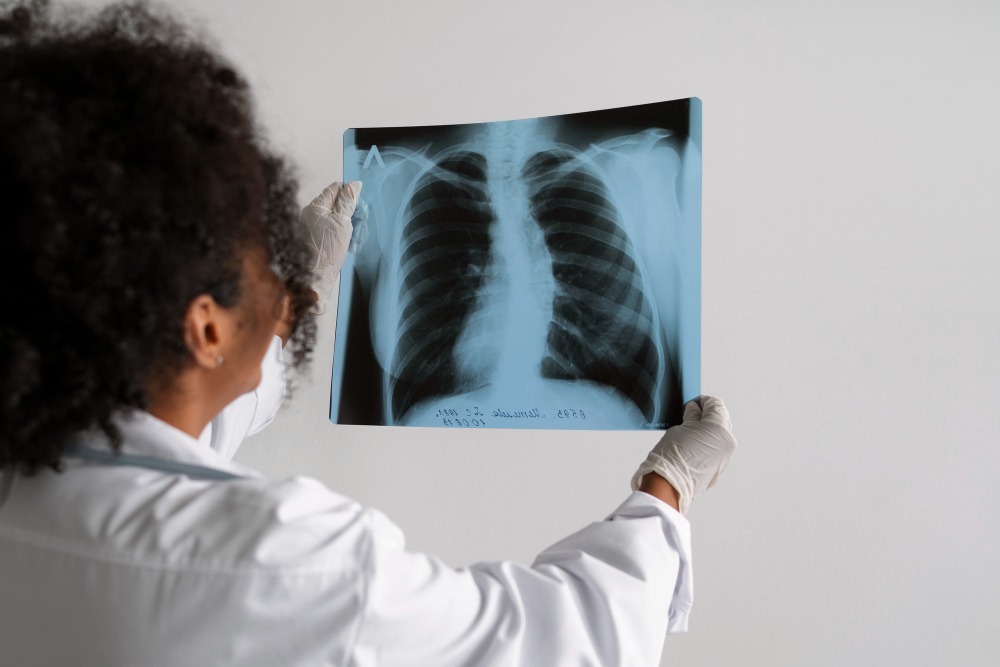Taking a deep breath might seem simple, but it’s crucial to life. Your lungs constantly work to absorb oxygen and release carbon dioxide, fueling every cell in your body.
Unfortunately, certain conditions, like pulmonary sarcoidosis (sar-coy-DOH-sis), threaten this vital function. Sarcoidosis is a rare, complex inflammatory disease that affects the lungs in 90% of people diagnosed with the disease. It also impacts other organs, including the eyes, skin, heart, and nervous system.
It’s estimated sarcoidosis impacts less than 200,000 people.1 But Black people, especially women, are the most affected. This highlights the need for awareness and understanding of this rare disease in the Black community. Addressing the reasons behind this disparity could help improve healthcare equity. Finding effective treatment options could also help. It could also ensure that everyone has the opportunity to breathe freely.
What is Pulmonary Sarcoidosis?
Pulmonary sarcoidosis2 affects the lungs, causing inflammation and the formation of small lumps called granulomas. The exact cause of pulmonary sarcoidosis is unknown. But, your environment and genetics play a role.3 For instance, if you have a family member with pulmonary sarcoidosis, you’re more likely to have it.
Every year, around 150,000-200,000 people1 are diagnosed with pulmonary sarcoidosis in the US. Most of the risk factors for this disease cannot be changed, such as4:
- Race: African or Scandinavian descent
- Gender: Female
- Age: 30 to 50 years old
- Genetics: Family history of pulmonary sarcoidosis
Other risk factors, such as living or working near insecticides, dusty or moldy environments, specific HIV and cancer medications, and lymphoma, also increase your risk.1
Symptoms of Pulmonary Sarcoidosis
Pulmonary sarcoidosis causes a range of symptoms including5:
- Persistent, dry cough
- Shortness of breath
- Chest pain
- Wheezing
- Fatigue
In severe cases, pulmonary sarcoidosis leads to permanent lung damage or scarring, called pulmonary fibrosis. This scarring causes difficulty breathing. In some cases, it affects the blood vessels, increasing the blood flow pressure in the lungs (pulmonary hypertension).
It’s important to note that these symptoms can vary in severity. You may even notice an overlap with other respiratory conditions, such as:
- Lung cancer
- Tuberculosis
- Chronic obstructive pulmonary disease (COPD)
If you or someone you know is experiencing these symptoms, you should speak with a healthcare provider. They can provide an accurate diagnosis and appropriate management.
Diagnosis of Pulmonary Sarcoidosis
There’s no single test to diagnose pulmonary sarcoidosis definitively. Your healthcare provider may start by gathering your complete medical history. They will also conduct a physical exam. They will listen to your lungs and check for other signs of inflammation.
They also typically use a combination of tests and procedures to make a diagnosis, including5:
- Chest X-ray: This shows evidence of granulomas in the lungs. It also helps stage your pulmonary sarcoidosis to determine the right treatment options.
- Chest CT scan: This provides a more detailed image of the lungs than a chest X-ray.
- Pulmonary function tests: These tests measure how well your lungs are working.
- Bronchoscopy: This test involves inserting a thin tube with a camera into the airways to look for granulomas.
- Biopsy: This test involves removing a small sample of tissue from the lungs for examination under a microscope.
Early diagnosis and treatment may help to prevent complications. They may also improve the long-term effects of pulmonary sarcoidosis.
Impact on Black People
Studies4 have shown that Black people are more likely to develop pulmonary sarcoidosis. They are also more likely to die from the disease. Similarly, Black women are nearly three times more likely6 to be diagnosed with pulmonary sarcoidosis in their lifetime. They also die at higher rates.
Pulmonary sarcoidosis is more severe in Black people than in other racial groups. They tend to show signs of the disease in their lungs and other body parts commonly affected. This leads to a higher likelihood of complications and death.
It’s unclear why Black people are more likely to be affected by pulmonary sarcoidosis. Researchers have identified several genes among Black people that increase the likelihood of having this disease. In fact, one study7 found that if you have a first-degree relative with pulmonary sarcoidosis, your risk of having the disease triples.
In addition to genetic factors, socioeconomic status has also been linked to higher rates of pulmonary sarcoidosis. Low income and lack of access to adequate health insurance7 lead to delays in care. When many come in for diagnosis and treatment, pulmonary sarcoidosis is found in later stages. This limits treatment options.
Treatment options for Pulmonary Sarcoidosis
The treatment of pulmonary sarcoidosis depends on the severity of symptoms. It also depends on the extent of organ involvement and individual patient factors. Some people with pulmonary sarcoidosis may not need treatment. Others may need options to manage symptoms and prevent complications.
There is no cure for sarcoidosis. Treatment primarily focuses on controlling inflammation and symptoms. For those without symptoms, healthcare providers may watch and wait for changes.
If you’re experiencing symptoms, your healthcare provider may use any of the following as treatment options:
- Corticosteroids
- Immunosuppressive medications
- Biologics
- Other Immune Modulators
- Antimalarial medications
In severe cases where pulmonary fibrosis or respiratory failure occurs, a lung transplant may be considered. However, transplantation is reserved for a small subset of people with end-stage disease.
People with pulmonary sarcoidosis need to work closely with their healthcare provider. Regular monitoring and follow-up help assess treatment effectiveness and adjust the management plan.
The Bottom Line
Pulmonary sarcoidosis poses a significant threat to those affected. The Black community has a notably higher prevalence. In fact, Black women face a higher likelihood of diagnosis and death due to this disease.
Although this disease has no cure. Improving access to treatment options could improve lives. By studying pulmonary sarcoidosis, people can help uncover why Black people are most often affected. This can refine treatment options and ultimately improve healthcare equity.
Your involvement can make a meaningful difference in the lives of those affected by this challenging condition. Join the effort to advance understanding, promote awareness, and work towards effective solutions for pulmonary sarcoidosis.
Conversation starters:
- Have you ever heard about pulmonary sarcoidosis? What are your thoughts on rare diseases and their awareness?
- Given that pulmonary sarcoidosis seems to affect the Black community more often, do you think there’s enough community awareness about the disease? How can communities work together to promote awareness and support those affected?
- Considering overall well-being, how important is it for individuals facing health challenges, like pulmonary sarcoidosis, to have a strong support system? What role do you think friends, family, and community can play?
References
- Association AL. Learn About Sarcoidosis. www.lung.org. https://www.lung.org/lung-health-diseases/lung-disease-lookup/sarcoidosis/learn-about-sarcoidosis#:~:text=Sarcoidosis%20most%20commonly%20affects%20the
- Belperio JA, Shaikh F, Abtin FG, et al. Diagnosis and Treatment of Pulmonary Sarcoidosis: A Review. JAMA. 2022;327(9):856-867. doi:10.1001/jama.2022.1570
- Jain R, Yadav D, Puranik N, Guleria R, Jin JO. Sarcoidosis: Causes, Diagnosis, Clinical Features, and Treatments. J Clin Med. 2020;9(4):1081. Published 2020 Apr 10. doi:10.3390/jcm9041081
- Judson MA. Environmental Risk Factors for Sarcoidosis. Front Immunol. 2020;11:1340. Published 2020 Jun 26. doi:10.3389/fimmu.2020.01340
- Pulmonary Sarcoidosis. John Hopkins Medicine. Published 2019. https://www.hopkinsmedicine.org/health/conditions-and-diseases/pulmonary-sarcoidosis
- Mirsaeidi M, Machado RF, Schraufnagel D, Sweiss NJ, Baughman RP. Racial difference in sarcoidosis mortality in the United States. Chest. 2015;147(2):438-449. doi:10.1378/chest.14-1120
- Hena KM. Sarcoidosis Epidemiology: Race Matters. Front Immunol. 2020;11:537382. Published 2020 Sep 15. doi:10.3389/fimmu.2020.537382



